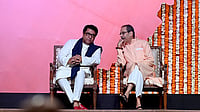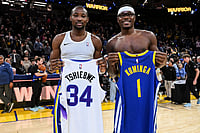The upwardly mobile couch potatos dilemma deepens. Just how is he going to juggle the remote control, the cigarette and the beer mug with just two hands? He was content watching his prime-time film on Star Movies with an occasional tnt all these years after cable TV came in. All of a sudden, in the past one year five new English movie channels have gone on air.
The menu now offers action films on axn, family entertainment on Kermit, the best of television films on Hallmark, the best of Hollywood on hbo, a little bit of everything from Hollywood on Zee Movies besides the classics on tnt and a lot more of Hollywood on Star Movies. Star, Hallmark, Zee Movies and hbo are on 24 hours. axn shows you three movies a day and four on weekends. tnt (now Turner Classic Movies or tcm after the arrival of hbo) is available prime-time.
But why is just everybody in town vying for his time? Doesnt he belong to a very small niche of English-programming aficionados? And dont English programming channels earn around a third of a mainstream Hindi channel?
It may appear to be a small audience but Star TV is already being watched by 14 million households, 2 million of which tune into Star Movies. tcm, owned by Turner International India Pvt Ltd, is available in 10 million homes. Hallmark Entertainment Network, which came in as late as June 99, has a potential clientele of nearly 6 million homes for its two channels Hallmark and Kermit. A year after going on air, axn TV, distributed by Sony, is estimated to be available in 12 million homes.
L.S. Nayak, Star TVs senior vice-president, sales and marketing, anticipates that more players in the market would mean more awareness and promotion for the entire films category and subsequently many more watchers. Look at sports television coverage, for instance. In the beginning, there was just Star Sports besides Doordarshan. Then came espn. With relentless advertising and promotion, the sports audience grew four times. Now Zee is poised to enter the arena.
Sai Nagesh, Contract Advertisings vice-president, media, finds that with the spread of literacy, Indians want to look out into the world and English TV programming is seen as extremely useful in broadening vision. Movies are high up on the priority list. Of English programming, movies have viewership ratings second only to cricket. "Cinema has always been the staple diet of Indians and as English is the language of the economy, commerce, business and higher education, the number of English-speaking people has to increase," explains Madhavi Mutatkar, deputy ceo, regional and English channels, Zee Telefilms. "With only 25 per cent of the c&s (cable and satellite) audience tuning in at prime-time, theres enough room to attract fresh audiences," adds the Sony Entertainment Television spokesperson for axn TV.
There are 30 million c&s homes in India. Over 60 per cent are in urban areas. With a total of nearly 70 million TV-owning homes in India, theres tremendous potential for further c&s penetration.
Already, against 16 Hindi channels there are 20 English programming channels of which seven are dedicated to films alone. Revenues for the latter are fast catching up with the former. English programming attracted over Rs 300 crore of advertising in the six-month period of June to December 99. Of this, Star Movies got over Rs 50 crore. Its earnings have grown four-fold over the past six years. tnt got over Rs 25 crore and axn TV Rs 14 crore. Kermit and Zee Movies are just beginning to take advertising while Hallmark and hbo arent taking any so far. Advertising on English-language channels is expected to grow by at least 25 per cent this financial year. English movie channels will earn close to Rs 175 crore by industry projections.
Star has probably broken the psychological barrier of becoming the countrys first pay channel and today the market is set for others to develop dual advertising revenues. hbo and tcm come as a package at Rs 8 per month per subscriber as does Star Movies. axn charges an average of Rs 4; Hallmark and Kermit are also pay channels. Zee Movies is going to go pay soon.
Everybody in the business is gung-ho about pushing every English-speaking viewer to stop by. For one, every channel has a strong usp which is now going to be hammered into the consumer psyche. Star Movies has exclusive tie-ups with leading studios in the US, including mgm, Walt Disney and Touchstone, to give the best of Hollywood movies. It has been doing "considerable" advertising on its own channels. Now theres added emphasis on out-of-the-box promotions, hoardings and print advertising. It is premiering successful movies like the latest James Bond film The World is not Enough and now the oven-hot Oscar-winning Boys Dont Cry. Advertising and promotion expenses of the channel will be doubled in the next fiscal.
Hallmark tops the network television productions in the US and brings the same films here. Hallmark films are made for viewing only on its own channel; so they are exclusive. They are typically classic stories and epics ranging from Arabian Nights to Alice in Wonderland. These boast big star casts, big budgets, exotic locations and compelling storylines. Hallmark recently flew down Hollywood star Jason Scott Lee who acts in Arabian Nights to promote the film and the channel in India. An eight-city roadshow and five-city advertising campaign will be complemented by every conceivable advertising channel - print, outdoor, ground promotions and the Net.
Action, says Sony for axn TV, cuts across language barriers thanks to which it has attracted viewers from non-English markets. Zee will get programming like Alfred Hitchcock and Charlie Chaplin "with which the English-speaking here identify".
Costs of setting up a movie channel is enormous. Besides the crores that go into setting up the infrastructure, software can be expensive. Satellite rights for Asia for a blockbuster Titanic, for instance, cost Star Movies $1.5 million. A regular A-grade film costs between $0.3 and 0.7 million. But all the players are looking long-term. Zee hopes to break even in three years. The others are looking at five to seven years.
India is a virtual delight for any English progamming channel. In Asia, it is the one country with a large English-speaking public. The channels are focused on arresting those shifty eyeballs. Says Anshuman Misra, managing director, Turner International: "We are concentrating on distribution and reach first, coupled with the best contemporary content (for hbo)."
Quality of experience is the mantra as the Indian viewer is getting discerning very rapidly. hbo delivers advertisement-free films and promises never to dub. It will accept advertising a few months down the line but that will be at the end of a film, not in between. Star Movies, which had become repetitive of late, is pulling up its socks. In the past month, several new movies have been added to its kitty. Turner International has complemented tcm with hbo to provide the entire gamut of Hollywood entertainment. Mutatkar promises to "break advertising smoothly" so that it is least annoying to the demanding viewer.
The scope and rate of growth of the market are exciting. Sony foresees an increase in the subscriber television movement. As signal distribution technology gets better and uses other media like the Internet besides cable and satellite, the viewer base can increase exponentially. Alongside, programming will get competitive and, therefore, better. The English channels are sitting on a virtual goldmine. It is just a matter of time before the moolah starts pouring in. In all this, of course, the real winner will be the couch potato.

























